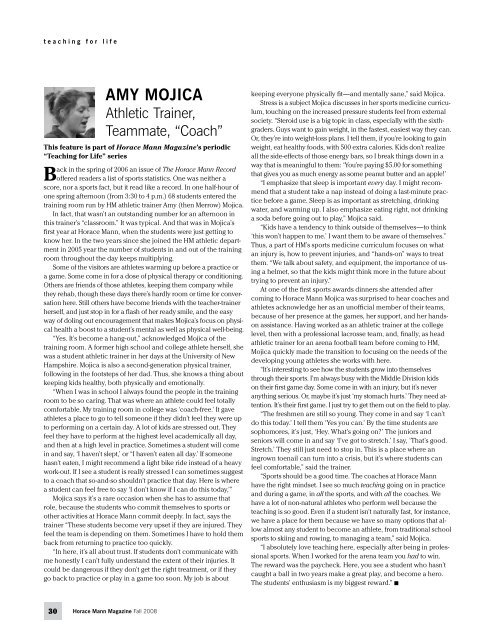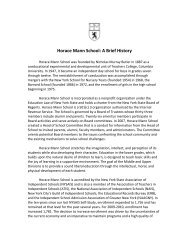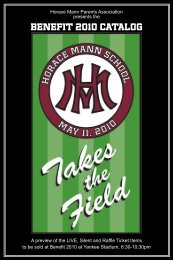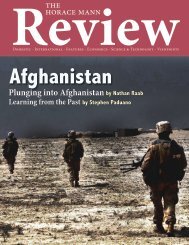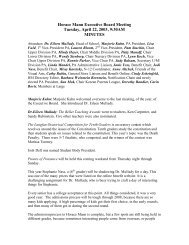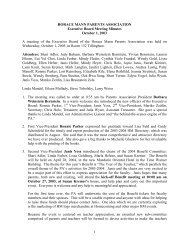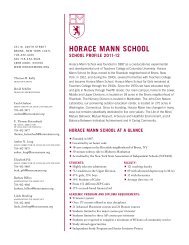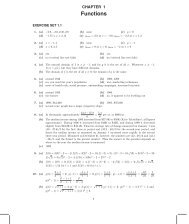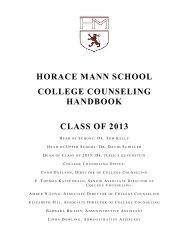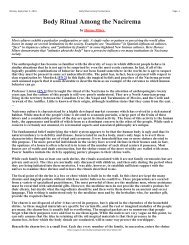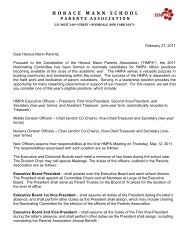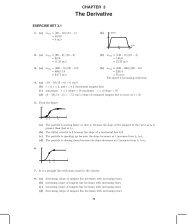You also want an ePaper? Increase the reach of your titles
YUMPU automatically turns print PDFs into web optimized ePapers that Google loves.
teaching for life<br />
Amy Mojica<br />
Athletic Trainer,<br />
Teamm<strong>at</strong>e, “Coach”<br />
This fe<strong>at</strong>ure is part of <strong>Horace</strong> <strong>Mann</strong> Magazine’s periodic<br />
“Teaching for Life” series<br />
Back in the spring of 2006 an issue of The <strong>Horace</strong> <strong>Mann</strong> Record<br />
offered readers a list of sports st<strong>at</strong>istics. One was neither a<br />
score, nor a sports fact, but it read like a record. In one half-hour of<br />
one spring afternoon (from 3:30 to 4 p.m.) 68 students entered the<br />
training room run by HM <strong>at</strong>hletic trainer Amy (then Merrow) Mojica.<br />
In fact, th<strong>at</strong> wasn’t an outstanding number for an afternoon in<br />
this trainer’s “classroom.” It was typical. And th<strong>at</strong> was in Mojica’s<br />
first year <strong>at</strong> <strong>Horace</strong> <strong>Mann</strong>, when the students were just getting to<br />
know her. In the two years since she joined the HM <strong>at</strong>hletic department<br />
in 2005 year the number of students in and out of the training<br />
room throughout the day keeps multiplying.<br />
Some of the visitors are <strong>at</strong>hletes warming up before a practice or<br />
a game. Some come in for a dose of physical therapy or conditioning.<br />
Others are friends of those <strong>at</strong>hletes, keeping them company while<br />
they rehab, though these days there’s hardly room or time for convers<strong>at</strong>ion<br />
here. Still others have become friends with the teacher-trainer<br />
herself, and just stop in for a flash of her ready smile, and the easy<br />
way of doling out encouragement th<strong>at</strong> makes Mojica’s focus on physical<br />
health a boost to a student’s mental as well as physical well-being.<br />
“Yes. It’s become a hang-out,” acknowledged Mojica of the<br />
training room. A former high school and college <strong>at</strong>hlete herself, she<br />
was a student <strong>at</strong>hletic trainer in her days <strong>at</strong> the University of New<br />
Hampshire. Mojica is also a second-gener<strong>at</strong>ion physical trainer,<br />
following in the footsteps of her dad. Thus, she knows a thing about<br />
keeping kids healthy, both physically and emotionally.<br />
“When I was in school I always found the people in the training<br />
room to be so caring. Th<strong>at</strong> was where an <strong>at</strong>hlete could feel totally<br />
comfortable. My training room in college was ‘coach-free.’ It gave<br />
<strong>at</strong>hletes a place to go to tell someone if they didn’t feel they were up<br />
to performing on a certain day. A lot of kids are stressed out. They<br />
feel they have to perform <strong>at</strong> the highest level academically all day,<br />
and then <strong>at</strong> a high level in practice. Sometimes a student will come<br />
in and say, ‘I haven’t slept,’ or “I haven’t e<strong>at</strong>en all day.’ If someone<br />
hasn’t e<strong>at</strong>en, I might recommend a light bike ride instead of a heavy<br />
work-out. If I see a student is really stressed I can sometimes suggest<br />
to a coach th<strong>at</strong> so-and-so shouldn’t practice th<strong>at</strong> day. Here is where<br />
a student can feel free to say ‘I don’t know if I can do this today,’”<br />
Mojica says it’s a rare occasion when she has to assume th<strong>at</strong><br />
role, because the students who commit themselves to sports or<br />
other activities <strong>at</strong> <strong>Horace</strong> <strong>Mann</strong> commit deeply. In fact, says the<br />
trainer “These students become very upset if they are injured. They<br />
feel the team is depending on them. Sometimes I have to hold them<br />
back from returning to practice too quickly.<br />
“In here, it’s all about trust. If students don’t communic<strong>at</strong>e with<br />
me honestly I can’t fully understand the extent of their injuries. It<br />
could be dangerous if they don’t get the right tre<strong>at</strong>ment, or if they<br />
go back to practice or play in a game too soon. My job is about<br />
keeping everyone physically fit—and mentally sane,” said Mojica.<br />
Stress is a subject Mojica discusses in her sports medicine curriculum,<br />
touching on the increased pressure students feel from external<br />
society. “Steroid use is a big topic in class, especially with the sixthgraders.<br />
Guys want to gain weight, in the fastest, easiest way they can.<br />
Or, they’re into weight-loss plans. I tell them, if you’re looking to gain<br />
weight, e<strong>at</strong> healthy foods, with 500 extra calories. Kids don’t realize<br />
all the side-effects of those energy bars, so I break things down in a<br />
way th<strong>at</strong> is meaningful to them: ‘You’re paying $5.00 for something<br />
th<strong>at</strong> gives you as much energy as some peanut butter and an apple!’<br />
“I emphasize th<strong>at</strong> sleep is important every day. I might recommend<br />
th<strong>at</strong> a student take a nap instead of doing a last-minute practice<br />
before a game. Sleep is as important as stretching, drinking<br />
w<strong>at</strong>er, and warming up. I also emphasize e<strong>at</strong>ing right, not drinking<br />
a soda before going out to play,” Mojica said.<br />
“Kids have a tendency to think outside of themselves—to think<br />
‘this won’t happen to me.’ I want them to be aware of themselves.”<br />
Thus, a part of HM’s sports medicine curriculum focuses on wh<strong>at</strong><br />
an injury is, how to prevent injuries, and “hands-on” ways to tre<strong>at</strong><br />
them. “We talk about safety, and equipment, the importance of using<br />
a helmet, so th<strong>at</strong> the kids might think more in the future about<br />
trying to prevent an injury.”<br />
At one of the first sports awards dinners she <strong>at</strong>tended after<br />
coming to <strong>Horace</strong> <strong>Mann</strong> Mojica was surprised to hear coaches and<br />
<strong>at</strong>hletes acknowledge her as an unofficial member of their teams,<br />
because of her presence <strong>at</strong> the games, her support, and her handson<br />
assistance. Having worked as an <strong>at</strong>hletic trainer <strong>at</strong> the college<br />
level, then with a professional lacrosse team, and, finally, as head<br />
<strong>at</strong>hletic trainer for an arena football team before coming to HM,<br />
Mojica quickly made the transition to focusing on the needs of the<br />
developing young <strong>at</strong>hletes she works with here.<br />
“It’s interesting to see how the students grow into themselves<br />
through their sports. I’m always busy with the Middle Division kids<br />
on their first game day. Some come in with an injury, but it’s never<br />
anything serious. Or, maybe it’s just ‘my stomach hurts.’ They need <strong>at</strong>tention.<br />
It’s their first game. I just try to get them out on the field to play.<br />
“The freshmen are still so young. They come in and say ‘I can’t<br />
do this today.’ I tell them ‘Yes you can.’ By the time students are<br />
sophomores, it’s just, ‘Hey. Wh<strong>at</strong>’s going on?’ The juniors and<br />
seniors will come in and say ‘I’ve got to stretch.’ I say, ‘Th<strong>at</strong>’s good.<br />
Stretch.’ They still just need to stop in. This is a place where an<br />
ingrown toenail can turn into a crisis, but it’s where students can<br />
feel comfortable,” said the trainer.<br />
“Sports should be a good time. The coaches <strong>at</strong> <strong>Horace</strong> <strong>Mann</strong><br />
have the right mindset. I see so much teaching going on in practice<br />
and during a game, in all the sports, and with all the coaches. We<br />
have a lot of non-n<strong>at</strong>ural <strong>at</strong>hletes who perform well because the<br />
teaching is so good. Even if a student isn’t n<strong>at</strong>urally fast, for instance,<br />
we have a place for them because we have so many options th<strong>at</strong> allow<br />
almost any student to become an <strong>at</strong>hlete, from traditional school<br />
sports to skiing and rowing, to managing a team,” said Mojica.<br />
“I absolutely love teaching here, especially after being in professional<br />
sports. When I worked for the arena team you had to win.<br />
The reward was the paycheck. Here, you see a student who hasn’t<br />
caught a ball in two years make a gre<strong>at</strong> play, and become a hero.<br />
The students’ enthusiasm is my biggest reward.” $<br />
30 <strong>Horace</strong> <strong>Mann</strong> Magazine Fall 2008


